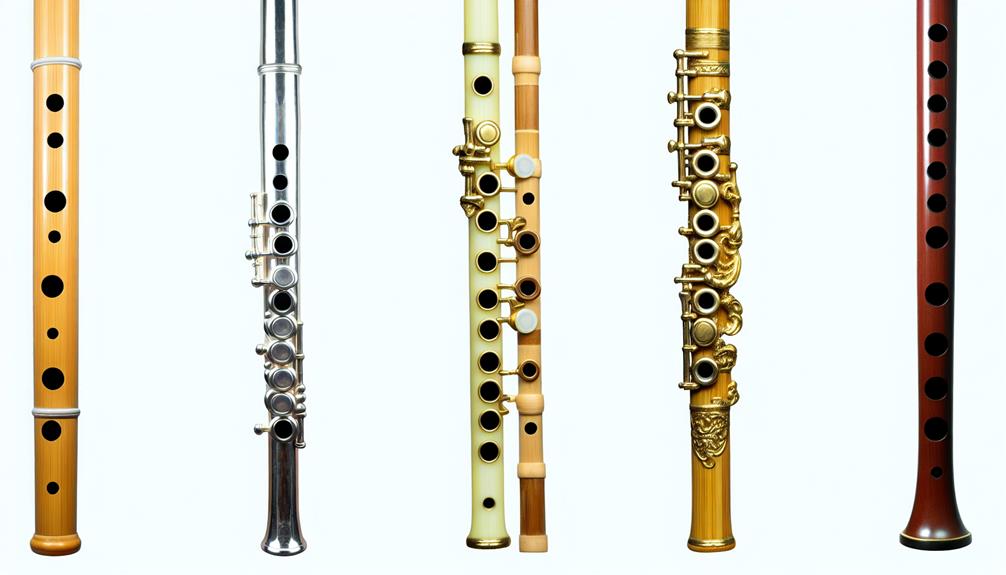When exploring the world of flutes, one may encounter a variety of options, each with its own unique characteristics and tonal qualities. Among the array of flutes available, three distinct types stand out as the main representatives of this versatile instrument: the concert flute, the alto flute, and the bass flute.
Each of these flutes offers a different range and sound, catering to various musical styles and preferences. Understanding the nuances of these three main flutes can provide valuable insights into the diverse possibilities that this instrument holds.
Key Takeaways
- Concert Flute: Bright and versatile, symbolizing sophistication.
- Alto Flute: Rich and mellow with extended range.
- Bass Flute: Deep, resonant tones, one octave lower.
- All flutes: Integral in ensembles, each with unique tonal characteristics.
Concert Flute
The Concert Flute, known for its bright and versatile sound, is a staple instrument in classical music ensembles worldwide. Its elegant design and melodic capabilities make it a favorite among musicians seeking to express themselves with clarity and precision. Typically made of silver, the Concert Flute produces a wide range of tones, from delicate and airy to powerful and resonant, allowing performers to convey a myriad of emotions through their music.
With a history dating back centuries, the Concert Flute has evolved to become a symbol of sophistication and artistry. Its presence in orchestras, chamber ensembles, and solo performances highlights its adaptability and importance in the classical music landscape. Aspiring flutists often choose to master the Concert Flute due to its prominence in musical repertoire and its ability to shine in various musical genres.
Alto Flute
Among the family of flutes, the Alto Flute stands out for its rich and mellow tone, adding depth and warmth to musical compositions. This unique instrument offers a captivating sound that enchants listeners and complements various musical ensembles.
- Lower register: The Alto Flute is known for its lower register, producing deep and resonant notes that create a solid foundation in music arrangements.
- Extended range: With a larger body and curved head joint, the Alto Flute has an extended range compared to the Concert Flute, allowing for the exploration of lower notes with clarity and precision.
- Versatility: This flute is versatile, adapting well to different music genres, from classical to jazz, adding a distinctive touch to any performance.
- Warm timbre: The Alto Flute's warm timbre evokes emotions and adds a touch of elegance to melodies, making it a sought-after instrument in orchestras and chamber music groups.
Bass Flute
Renowned for its deep and resonant tones, the Bass Flute is a distinctive member of the flute family, offering a unique richness to musical performances. This larger and lower-pitched instrument is an integral part of orchestras and chamber ensembles, adding depth and color to compositions. The Bass Flute is pitched in the key of C, sounding one octave lower than the concert flute. Its velvety timbre and extended range make it a versatile instrument suited for both solo and ensemble playing.
To further understand the characteristics of the Bass Flute, let's explore some key features in the table below:
| Feature | Description |
|---|---|
| Size | Larger than a standard flute, approximately 51 inches in length |
| Material | Typically made of silver, gold, or other metals for durability |
| Range | Capable of producing notes from C3 to C7, extending below the staff |
| Sound Quality | Rich and resonant, with a warm and velvety tone quality |
| Playing Technique | Requires slightly different fingerings and embouchure than a concert flute |
The Bass Flute's distinctive characteristics make it a valuable addition to any ensemble, enriching the overall sound and offering a unique listening experience.
Frequently Asked Questions
What Are the Differences in Sound Between a Concert Flute, Alto Flute, and Bass Flute?
When comparing the concert flute, alto flute, and bass flute, it's fascinating to note that each generates unique tones due to their size and design. The concert flute produces bright, clear sounds, while the alto and bass flutes offer deeper, richer tones, creating a diverse musical palette.
Are There Any Other Types of Flutes Besides the Concert, Alto, and Bass Flutes?
There are various types of flutes beyond the commonly known concert, alto, and bass flutes. These include ethnic flutes like the bansuri and shakuhachi, historical flutes such as the traverso, and modern variants like the piccolo and double contrabass flute.
Can the Alto Flute and Bass Flute Be Used in Orchestral Settings?
The alto flute and bass flute can be effectively utilized in orchestral settings, adding depth and richness to the ensemble's sound. Their unique timbres offer composers and conductors additional tonal colors to enhance musical arrangements.
How Do the Fingerings Differ Between the Concert Flute, Alto Flute, and Bass Flute?
The fingerings between the concert flute, alto flute, and bass flute differ due to variations in their sizes and keys. Each flute requires specific finger placements to produce accurate notes. Understanding these distinctions is crucial for proficient flute performance across different instruments.
Are There Any Famous Composers or Pieces of Music That Specifically Feature the Alto or Bass Flute?
Renowned composers such as Debussy, Mahler, and Prokofiev have showcased the alto and bass flutes in their compositions, adding depth and richness to their music. These instruments lend a unique and enchanting quality to various musical pieces.
Conclusion
In conclusion, the Concert Flute, Alto Flute, and Bass Flute are the three main types of flutes commonly found in musical ensembles. Each flute offers unique tonal qualities and ranges, contributing to the overall sound of the ensemble. The versatility of these flutes allows for a wide range of musical expression, making them essential instruments in various genres of music.
Overall, the flutes are like a symphony of sound, creating a harmonious blend that captivates listeners.

